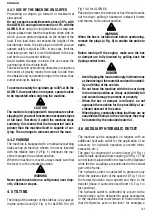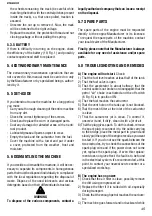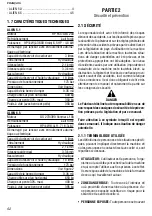
37
to the required specifications;
- check that there are all the parts that make up the
machine and that the machine is free from any
type of damage;
- immediately contact the Manufacturer in case
one of the above checks are not successful.
3.2 HANDLING
3.2.1 UNLOADING THE MACHINE
The machine can be supplied on pallets or as it is.
If the machine is supplied on pallets, handling must
be done with a forklift truck with forks of appropriate
size and capacity (for the weight of the machine, see
«1.7 Technical features»).
If the machine is supplied complete and as it is and
you can operate it, the handling can happen in two
ways:
1) BY UP/DOWN RAMPS
The ramps for loading/unloading will have a capac-
ity of at least 300 kilograms each. They must be
at least 30 cm wide, have side edges raised of at
least 5 cm, a length such as to ensure that their
inclination does not exceed 15°/20° inclination and
be equipped with a system of secure coupling to
the transport means.
During unloading or loading, proceed with caution
driving the machine on foot at reduced speed,
paying attention and taking properly the ramps
and walking on them safely.
2) BY CRANE OR HOIST WITH HOOKS AND ROPES
Should it be necessary to lift the machine with
cranes or hoists, transfer it to a different level
than that in which it is located and use appropriate
cables, chains or straps.
The attachment points for lifting with hooks and
ropes are identified on the machine with the sym
-
bol «hook» (13, Fig. 3). See Figure 4 in the two
possibilities of coupling «A» and «B».
Before you start lifting, check that the weight is
properly balanced and that the machine is always
kept in a horizontal position.
WARNING
Lifting the machine must always be when the box
or dump is empty and when the engine is off.
Keep in mind also that the surrounding area is con-
sidered at risk of falling of the vehicle. There must
be no unauthorized persons and/or animals.
It is absolutely forbidden to lift the machine when
it is loaded or when the accessories are applied
to it.
DANGER
Unloading can be very dangerous if not performed
with extreme caution.
Before starting the unloading, therefore, remove
the unauthorized perspns; clear and demarcate the
area of transfer and check the firmness of the ground
where the machine will be placed.
CAUTION
The area where you plan to unload the machine
must be leveled to prevent possible movement of
the load.
You must also ensure that the area where you act
is clear and there is enough “space of escape”,
that is, a free and safe area, where you can move
quickly in the event that the load falls.
The means of transport must have the engine turned
off, the gear enabled and the parking brake applied.
The handling must always be performed when the
machine is empty (without any load).
3.2.2 DISPOSAL OF PACKAGING
The machine and any auxiliary equipment are pro
-
vided loaded on pallets or special packaging card-
boards and wood cases.
If any one or more accessories are installed, the
machine comes with an accessory already mounted.
Any other accessories are packed separately.
Unpacking and disposal of packaging materials are
the responsibility of the User, who must follow the
laws in force in the country of use of the machine.
Dispose of the materials dividing them into various
types.
3.2.3 LOADING THE MACHINE
Should it be necessary to move the machine in other
operating areas, you can load it on suitable means of
transport, using the same methods described above
for its unloading:
- With forklift and palletized machine;
- With up/down ramps;
ENGLISH
















































